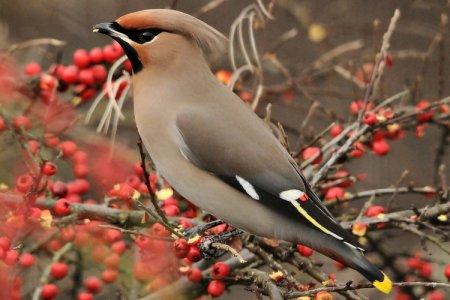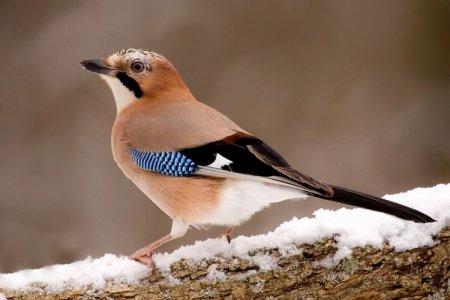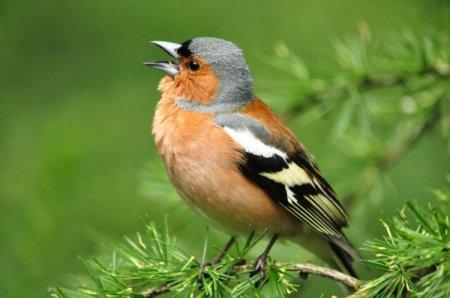
If you have come across a small nimble bird that looks like a fluffy ball with an orange breast, this is a robin. It is also called a robin, and in many cultures it is considered a harbinger of a good day.
general description
The robin belongs to the blackbirds, and its closest relatives are the nightingales. But outwardly, these birds are completely different, at least due to the location of the calf relative to the paws.
Appearance
The robins are very tiny - up to 22 g in weight and 14 cm in length. They have a black short and sharp beak, black beady eyes and long legs with the same long claws to cling to branches. The back of the bird is gray-green with a brown tint, the belly is white or gray, but the breast and part of the head are of a bright red color.
Curiously, the plumage of robins from the southern regions is usually brighter. In addition, young chicks differ - they are variegated, with brown spots, but completely inconspicuous against the background of branches and foliage. This disguise protects them from danger.

Male and female robins: differences
Male and female robins differ little from each other. Is that the color of the female is a little paler and there is not such a clear separation between the head and back. But this is difficult to notice until you put two birds side by side.
But their habits are different. In particular, males are very aggressive towards each other, because robins are terrible owners by nature. And also because there are much more females in nature than males, and they are often left without a pair.

Singing
Robin is a songbird, and her song is very melodic and harmonious. It is a set of high-pitched sibilants that are woven into a complex melody. Robins sing mainly after sunset, and during the mating season only males sing, and the rest of the time - males and females.

How many robins live
On average, robins live about 5 years, but cases are known up to 12. Moreover, their life cycle is slightly different from the usual one. For example, robins breed twice a year.

Types of robins
Among the robins, several interesting subspecies can be distinguished, which we would like to talk about separately. And some of them are not at all like their relatives!
Black-throated robin
This is a kind of robin on the contrary - with a red back and black breast. They live in some regions of Asia, and especially on the Japanese island of Ryukyu, where they are considered local nightingales.

Japanese robin
Lives not only in Japan, but also in China and Sakhalin. Their coloration is generally similar, but with the addition of blue and black specks in the plumage of males. But the females are usually brown.

Javanese robin
This is the star of the island of Java, although it lives not only there. As a resident of hot regions, she is very vibrant and sedentary.

White-tailed robin
This is a mountain species, which, with its tiny size, is more like a dove in the shape of a calf. The plumage is distinctly blue. Mountain robins are common in Siberia and the Caucasus.

Blue-blue robin
Another alpine variety, but with unusual blue-blue shades. It is widespread in Africa, Asia and Indonesia, so it is extremely unlikely to meet it in Russia.

Lifestyle
Robins get along well with people and are not at all afraid of them. It is quite possible to feed small bright birds and admire them somewhere in the city park. But in relation to relatives, robins are single, so they live and fly away to winter separately.
Habitat
The robin is found throughout Europe, as well as in parts of Asia and Africa. She prefers to hide in the forests, but nowadays she is increasingly moving to gardens, squares and parks in search of food.

The diet
Most robins love seeds and berries.In addition, they are excellent hunters for small insects, so that the basis of their diet is beetles, spiders, centipedes and all kinds of worms. The sharp, thin beak even allows snails to be hunted.

Wintering
Robins from the southern regions are sedentary. But the rest have to migrate for the winter closer to warmth - to certain regions of Africa, Asia and Western Europe. In early spring, they return to their homes. First, the males arrive and occupy the territory, and then the females come to them.

Keeping in captivity
The robin can be tamed, and it will even feel quite comfortable in captivity. Perhaps this is due to the fact that such a practice has been common for centuries thanks to her unique singing talents. A robin is unpretentious in everyday life if you provide it with live insects and a bath for bathing.

Reproduction of a robin
Robins nest closer to the ground and hide in crevices of stumps and roots. They love abandoned burrows and other secluded spots that are reinforced with moss, twigs and leaves. Robins always carefully protect their nest from rain.
Nests are usually built by females, while males defend the territory from competitors. Then the males take care of the small chicks at night, while the females incubate the second clutch. In general, robins have a very developed parental instinct.
One clutch contains 5-7 blue eggs, of which chicks appear in 2 weeks. At first they are very voracious, but then they grow quickly and after 2 weeks they try to leave the nest. The hardest thing for robins is the first year of life, because they are not at all shy and not too careful, which is why many chicks die.

Natural enemies
Man carries minimal threat to robins. They even managed to adapt to deforestation and reduced nesting sites. But owls, falcons, weasels, martens and ermines willingly attack small gullible birds and often destroy nests located too close to the ground.

Robin - photo
Miniature robins on long thin legs look just charming. Is not it?

























